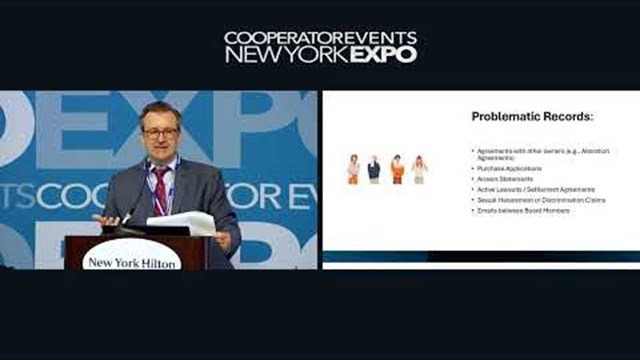It takes many vital components working in unison to enable a residential multifamily building to function effectively: a management team to help things run smoothly, committed, engaged board members who volunteer their time, and residents who take an interest in its governance and administration of the building they call home. They all need to communicate clearly and consistently to be successful. From misinformation to legal and liability issues, poor communication can disrupt a building’s operations and lead to tension and acrimony in the community. When communication breaks down, the repercussions can ripple outward into even bigger problems.
According to Jaime Sikorski, senior VP at AKAM Property Management, making sure everyone is in alignment with shared goals is imperative to board success. She says, “The most successful communication stories center around the goals for the co-op or condo, whether improving quality of life or reducing costs. It’s looking at the overarching goals and explaining how the decisions or actions fit into those goals.”
Daniel Wollman, CEO of Gumley Haft, stresses the importance of setting clear expectations in communication. “It’s about explaining the ‘why’ behind certain rules. Be clear, set expectations, and explain why certain actions are necessary.”
Sikorski echoes this, adding, “It’s about understanding the ‘why’ and not just the ‘how.’ When people grasp the goals and are on board, they are more likely to be open to solutions. Strong communication requires a two-way dialogue.” When everyone is on the same page, they can work together towards a shared objective.
Attorney Marc H. Schneider of Schneider Buchel LLP also stresses the importance of transparency. “When a board wants to pass amendments to governing documents involving a potentially controversial or impactful issue,” he says, “there should be an informational meeting noticed, and a discussion ahead of time before the amendments are formally proposed for a vote. Boards shouldn’t try to pass these types of amendments without getting community buy-in first. When you involve the whole community in discussion first, you are more likely to get things passed.”
Another area to navigate carefully is where finances are concerned. “You should always be upfront about fees. Most shareholders are generally apathetic so long as fees are reasonable and the building is running well. It’s important to get in front of large issues and do your due diligence as a board to communicate to the building,” Wollman adds.
Along with not listening to the unit owners and shareholders and their priorities, “The biggest example of poor communication is not communicating at all,” says Sikorski. “Sometimes, in areas where there is a need for significant board discussion and due diligence, it comes with an assumption that everyone is already on the same page. Not reaching people, or making assumptions that accurate communication is out there is the biggest pitfall.
Wollman further adds, “Sometimes, boards don’t think they need to communicate, or they think that because they are elected, they are entrusted to make decisions unilaterally. That’s not always the case.”
The Ripple Effect
Poor communication can have a ripple effect on a community. “When interactions break down, it gives way to rumors and conspiracy theories,” says Sikorski. “Misinformation can start snowballing with a lack of communication or misguided exchanges from people who may not have all the correct information.”
“I think poor communication boils down to assumptions,” she continues. “I’ve seen boards assume everyone understands what’s going on. There’s very often a level of trust, but you may hit on something more important to shareholders and residents, and that trust may not bridge the gap. I don’t think it’s ever intentional. Everyone is so busy, particularly board members, who serve voluntarily. They’re often so focused on getting the projects done right that they sometimes forget the importance of communication. It’s innocent, but still has repercussions.”
Wollman adds that when not done mindfully, “Communication can create bad blood or unhappy residents. If possible, meet often and be transparent. This will temper incorrect data being spread around that can cause people to become unnecessarily upset.”
Schneider says, “Among board members, there is often a reluctance to give airtime to those with opposing views. It’s okay to disagree—some of the best decisions come from disagreements and open dialogue about differing perspectives.”
Considering Legal & Liability
As problematic as silence and unresponsiveness can be, the opposite—disclosing too much information, to inappropriate parties—can be just as damaging. If a board member discloses sensitive board information on their own (without prior approval), exposing the board to legal liability, for example. Not all information is for public consumption, says Wollman. “Boards sometimes have to deal with confidential information, so they can’t communicate all of it publicly.”
“It’s so important that communication stays within the board room,“ says Schneider. “For example, I’ve seen situations where a board is considering an applicant, and, for what might be perceived as an arbitrary reason, decides not to approve the applicant. If that conversation gets out through a board member discussing it outside the board room, it can quickly escalate into a discrimination claim. Another example of a liability risk would be if the board is discussing the circumstances surrounding a resident in arrears. These discussions should remain in the boardroom. Confidentiality is essential to protecting the board and the community.”
Schneider goes on to observe board members often don’t seem to realize that their communications outside the boardroom can lead to legal exposure. Emails and even texts become discoverable in a lawsuit, he says, and “these things lack context and tone, and can get you into trouble as they can easily be misinterpreted. They put you in a position where you have to explain yourself in a legal setting. So before you hit the Send button, count to three, and see if you still want to send that communication out.”
Sikorski adds that “the other thing that can potentially become litigious one way or another is when boards or board members speak to the minority voice, which can often be louder than the majority.” She notes that one person spreading incorrect information or divisiveness can have a corrosive effect, both among board members and between board and residents. “Things become personal instead of focusing on the goals of the building,” she says. “I always go back to the goals of the building. As long as you are focused on those, there’s less chance of it becoming personal.”
Managing Sensitive Information
According to Wollman, the handling of controversial or sensitive information can sometimes be tough to navigate, particularly when communicating it via newsletters and notices. “I like the idea of meeting with people in person and having open meetings instead of putting things in writing,” he says. “This creates room for dialogue and makes it easier to communicate on sensitive topics. It also helps you avoid explaining the board’s decisions by allowing them to lay out facts and control the meeting. The board can facilitate the best way to disseminate data to the shareholders.”
That said, “You are not required to disclose the reasoning behind every board decision,” adds Schneider. “Transparency is good; but meeting minutes should reflect the action of the board, rather than the back and forth discussions that led to the decision.” Having a plan for what information needs to be shared and how to circulate that information best can help keep things clear and minimize risk of misinterpretation–innocent or otherwise–and legal issues.
Again, Sikorski reiterates that “when you express the ‘why’ as well as the ‘what’ and ‘how’, it goes a long way. I think it comes down to knowing your audience. I’ve seen buildings go into a lot of detail when it comes to mechanicals and costly repairs because the culture of the building is full transparency, and they know their residents want to see the nitty-gritty of the mechanicals. I’ve seen other buildings focus more on the financials, the 5-year plan, and return on investments. It’s important to consider the quality of life versus the value of your unit. One is never exclusive to the other, but knowing your audience can help you best communicate to all your building’s residents.”
“Utilizing new technology is good,” Sikorski continues, “but never leave behind the tried-and-true human component. There are limitations to communicating one way. Having an in-person conversation and answering questions goes a long way; doing it in different forms can also help. People like to receive data on different levels of convenience. Holding a town hall meeting is a great addition for auditory learners who receive information better. Sometimes, follow-up sessions like smaller roundtables or committees are necessary for success.”
Keep it Personable & Professional
Schneider says, “Maintaining professionalism is essential, especially when you have a situation where there could be significant consequences. It’s a majority vote, not a unanimous vote. You need to allow everyone to be heard. In the end, the majority vote is what determines the outcome and decision. If you consistently shut out a board member or resident, it leads to bigger issues, as that board member will often then take their grievances outside the board to the community.”
Ultimately, avoiding poor communication requires a cohesive plan that pays attention to the needs of everyone in the building. Board members need a consistent message and an understanding of how to convey messages to their shareholders best. Shareholders are encouraged to actively listen and express their concerns to the board early on. Management companies act as a bridge to keep the lines of communication clear.
“The key to avoiding poor communication is understanding how people think and learn. Some people are visual learners, while others are auditory learners. Recognizing these differences helps determine the best steps forward,“ says Sikorski.
All in all, if board members, shareholders, and management companies coordinate their efforts and work congruently towards a shared objective, they can avoid poor communication and its consequences.
Kate Mattiace is Associate Editor of CooperatorNews.










Leave a Comment